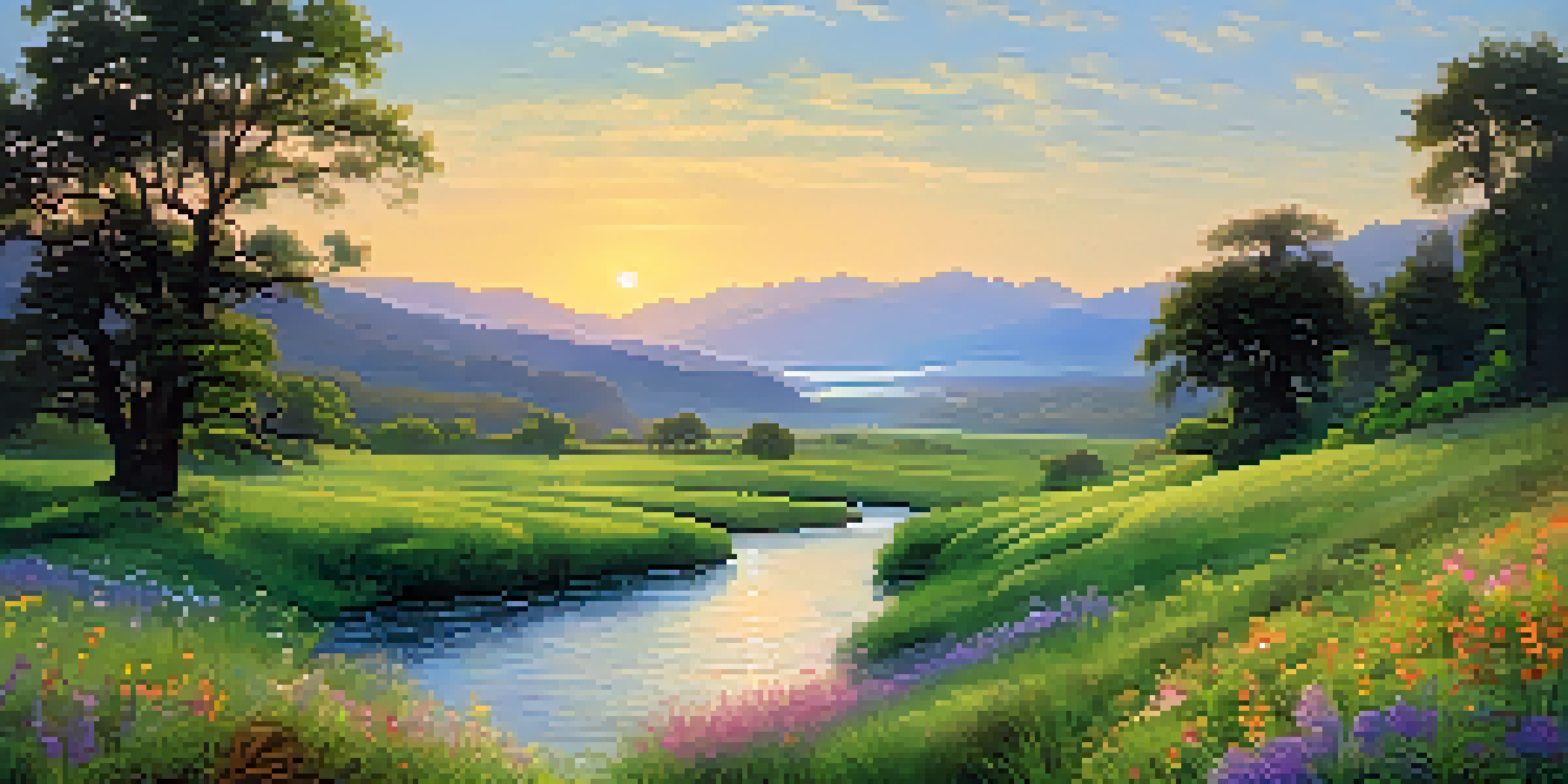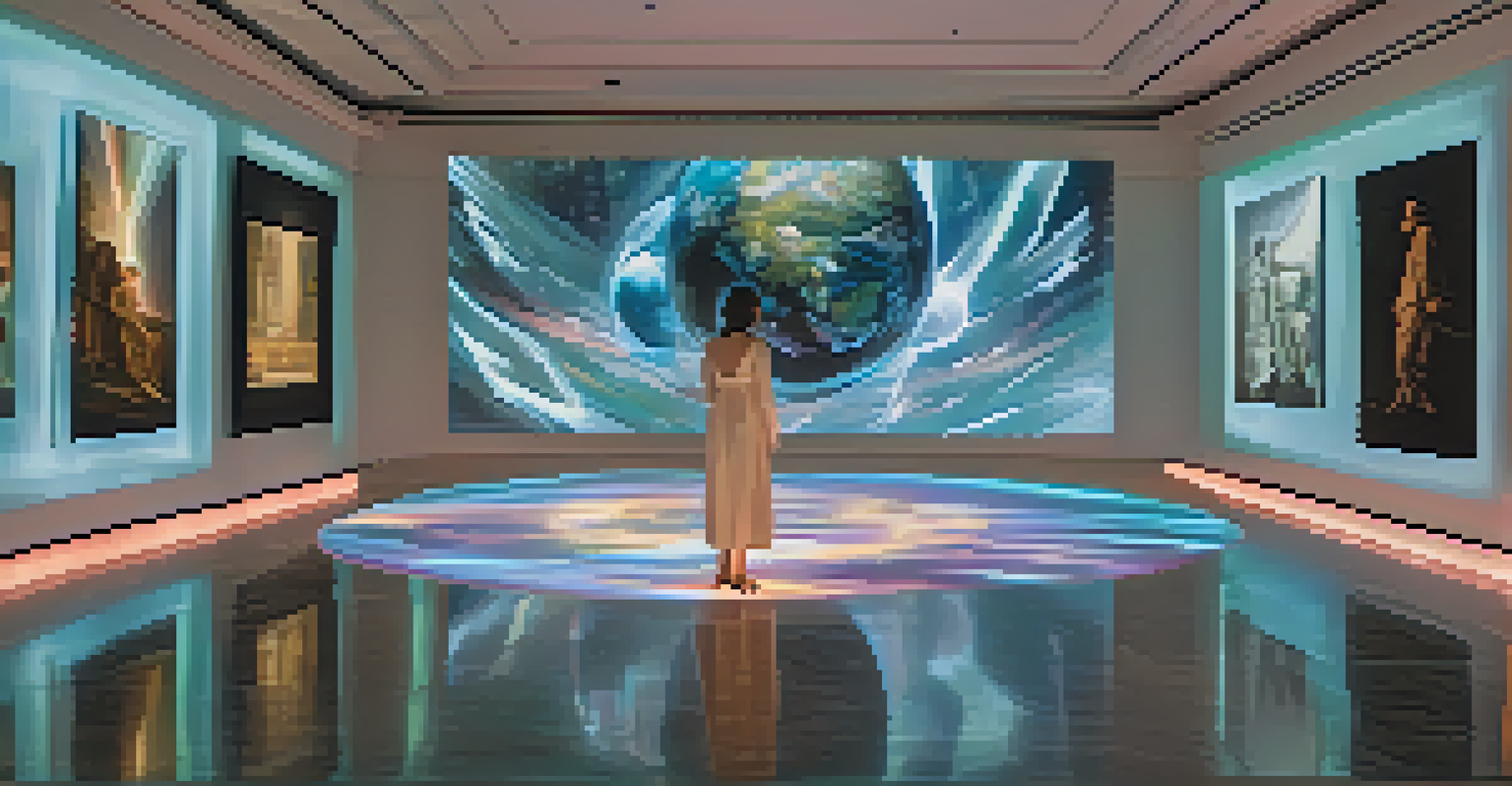From Canvas to Screen: The Evolution of Painting Practices

The Origins of Painting: A Brief History
Painting has a rich history, dating back to prehistoric times when early humans used natural pigments to create cave art. These first expressions of creativity were not merely decorative; they served as a means of storytelling and communication. Over the centuries, painting evolved through various movements, such as the Renaissance, where artists like Leonardo da Vinci brought a scientific approach to their craft, blending art with observation.
Every artist dips his brush in his own soul, and paints his own nature into his pictures.
These foundational practices laid the groundwork for modern art, influencing countless artists along the way. For instance, the use of perspective and anatomy in Renaissance paintings shifted how subsequent generations approached composition. This evolution was not just technical; it was also philosophical, prompting questions about the role of the artist and the purpose of art itself.
As we moved into the 19th and 20th centuries, movements like Impressionism and Abstract Expressionism challenged traditional notions of beauty, paving the way for more experimental forms of painting. Each era contributed to the rich tapestry of art history, setting the stage for the next leap into the digital realm.
The Advent of Digital Painting
The introduction of computers and digital technology in the late 20th century marked a significant turning point for artists. Digital painting emerged as a new medium, providing a canvas that could be edited endlessly without the fear of making irreversible mistakes. Artists quickly embraced software like Adobe Photoshop and Corel Painter, utilizing tools that mimicked traditional brushes and textures.

What made digital painting particularly appealing was its accessibility; artists could create stunning works with just a tablet and stylus. This democratization of art allowed many budding creators to experiment with styles and techniques that may have seemed daunting in traditional formats. Moreover, the ability to easily share work online fostered a global community of artists, breaking geographical barriers.
Evolution of Painting Techniques
Painting has transformed from prehistoric cave art to modern digital practices, blending traditional and innovative methods.
However, this shift also sparked debates about authenticity and originality in art. Questions arose regarding the value of digital artwork compared to traditional pieces, prompting artists to find new ways to assert their unique voices in this evolving landscape.
Blending Traditional Techniques with Digital Tools
As digital painting gained traction, many artists began to blend traditional techniques with digital tools, creating unique hybrid styles. For example, some artists might start with a pencil sketch on paper, scan it, and then enhance it digitally using various software. This fusion of mediums allows for greater experimentation and innovation, pushing the boundaries of what painting can be.
Art is not freedom from discipline, but disciplined freedom.
By utilizing both methods, artists can achieve textures and effects that may be impossible to recreate with traditional paints alone. This approach not only enriches the artwork but also reflects the diverse influences of the modern age. An artist's ability to switch between mediums can lead to exciting discoveries, making each piece a testament to their creative journey.
This hybridization has led to new genres within the art world, such as digital collage and augmented reality art. These genres invite viewers to engage with art in dynamic ways, further blurring the lines between the physical and digital realms.
The Role of Technology in Artistic Expression
Technology has become a pivotal aspect of artistic expression in the 21st century. From 3D modeling to augmented reality, artists now have a plethora of tools at their disposal to create immersive experiences. This expansion of capabilities allows artists to challenge conventional boundaries and invite viewer interaction, transforming passive observation into active participation.
For instance, installations that incorporate projection mapping can alter how we perceive a painting, adding layers of meaning that static images simply cannot convey. Artists like Refik Anadol use algorithms to create mesmerizing visual displays, merging data and aesthetics in groundbreaking ways. These innovations not only captivate audiences but also provoke thought about the relationship between art and technology.
Impact of Technology on Art
Technology has revolutionized artistic expression, enabling immersive experiences and challenging conventional boundaries in art.
Furthermore, as technology continues to advance, so too does the potential for new forms of storytelling. Artists are now tasked with exploring how to communicate their messages effectively in this fast-paced digital world, encouraging them to think critically about the intersection of art, culture, and technology.
The Impact of Social Media on Art Practice
In today’s digital age, social media platforms have revolutionized how artists share their work and connect with audiences. Platforms like Instagram and TikTok have become essential tools for promoting art, allowing artists to showcase their creations to a global audience. This instant access to a vast network has empowered many artists, enabling them to build personal brands and communities around their work.
Social media not only offers a platform for visibility but also facilitates direct engagement with fans and fellow artists. Feedback comes instantly, which can be both encouraging and challenging for creators. As they navigate this new landscape, many artists embrace the opportunity to collaborate, share techniques, and inspire one another, fostering a sense of camaraderie in the artistic community.
However, the pressure to maintain a constant online presence can also lead to burnout, as artists grapple with the balance between creating for themselves versus creating for an audience. This dynamic raises questions about artistic integrity and the true purpose of art in a world increasingly driven by likes and shares.
Challenges and Controversies in Digital Art
While digital art has opened many doors, it hasn’t come without its challenges and controversies. Issues such as copyright infringement and the use of AI-generated art have sparked debates about ownership and authenticity in the digital realm. As technology evolves, so too do the gray areas surrounding what constitutes an original piece of art.
Many artists express concerns about the implications of AI in creative processes, fearing that automation could undermine the value of human creativity. While AI can assist in generating ideas or enhancing techniques, it raises existential questions about the role of the artist. Can a machine truly replicate the emotional depth and intention that comes from human experience?
Social Media's Role in Art
Social media platforms have become vital for artists to showcase their work and connect with global audiences, while also presenting challenges of artistic integrity.
Furthermore, the proliferation of digital art can lead to market saturation, making it harder for individual artists to distinguish themselves. As they navigate this complex landscape, artists must continue to adapt and find innovative ways to assert their unique perspectives while staying true to their creative visions.
The Future of Painting: What Lies Ahead
As we look to the future, the evolution of painting practices is likely to continue, influenced by ongoing technological advancements and cultural shifts. The lines between traditional and digital art will likely blur even further, leading to new genres and forms of expression that we haven’t yet imagined. Artists will continue to explore the potential of virtual reality, interactive installations, and immersive experiences to engage audiences in unprecedented ways.
Moreover, the rise of NFTs (non-fungible tokens) has introduced new dimensions to ownership and value in the art world. This digital evolution challenges traditional art markets, offering artists alternative revenue streams while also raising questions about sustainability and accessibility. As the art world adapts to these changes, creators will need to navigate the implications of their work in a rapidly transforming landscape.

Ultimately, the future of painting holds endless possibilities, driven by the creative spirit of artists who dare to explore. Whether on canvas or screen, the essence of painting remains the same: a reflection of human experience, emotion, and connection—timeless traits that will continue to resonate across mediums for generations to come.